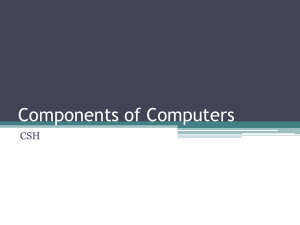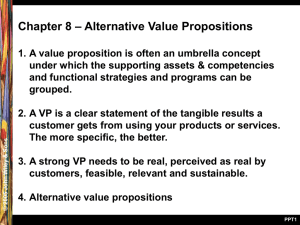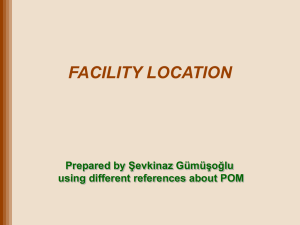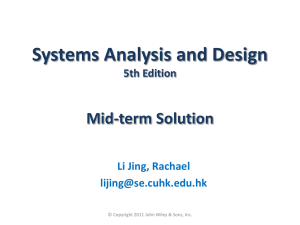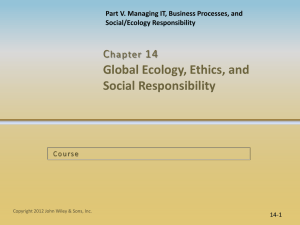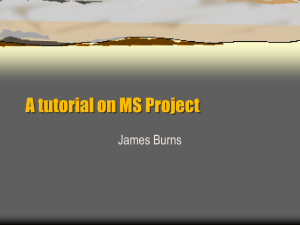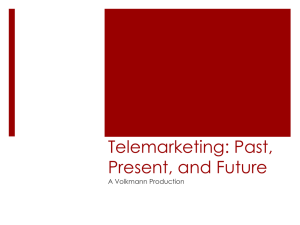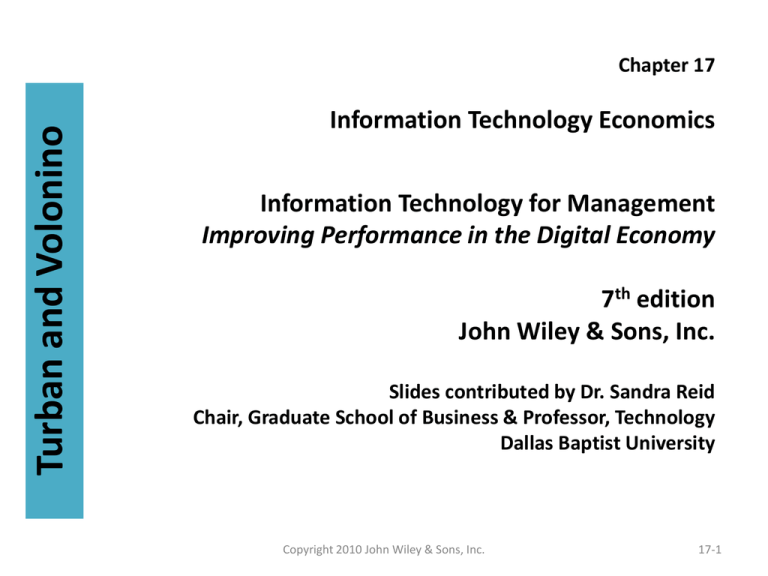
Turban and Volonino
Chapter 17
Information Technology Economics
Information Technology for Management
Improving Performance in the Digital Economy
7th edition
John Wiley & Sons, Inc.
Slides contributed by Dr. Sandra Reid
Chair, Graduate School of Business & Professor, Technology
Dallas Baptist University
Copyright 2010 John Wiley & Sons, Inc.
17-1
Chapter Outline
• 17.1 Technology and Economic Trends and the
Productivity Paradox.
• 17.2 Evaluating IT Investments: Needs,
Benefits, Issues, and Traditional Methods.
• 17.3 Advanced Methods for Justifying IT
Investment and Using IT Metrics.
• 17.4 Examples of IT Project Justification.
Copyright 2010 John Wiley & Sons, Inc.
17-2
Chapter Outline – cont’d
• 17.5 Economic Aspects of IT and Web-Based
Systems.
• 17.6 Managerial Issues.
Copyright 2010 John Wiley & Sons, Inc.
17-3
Learning Objectives
1. Identify the major aspects of the economics
of information technology.
2. Explain and discuss the productivity paradox.
3. Describe approaches for evaluating IT
investment and explain why it is difficult to
do it.
4. Understand the nature of intangible benefits
and the approaches to deal with such
benefits.
Copyright 2010 John Wiley & Sons, Inc.
17-4
Learning Objectives – cont’d
5. List and briefly describe the traditional and
modern methods of justifying IT investment.
6. Identify the advantages and disadvantages of
approaches to charging end users for IT services
(chargeback).
7. Understand and describe the IT justification
process via examples.
8. Understand some major economic impacts of IT
and EC.
9. Describe economic issues related to Web-based
technologies including e-commerce.
Copyright 2010 John Wiley & Sons, Inc.
17-5
Figure IT7eU
Copyright 2010 John Wiley & Sons, Inc.
17-6
(Formerly California State Automobile Association)
• Problem – IT infrastructures nearing end of life. Vendors no
longer supported OS, security patches & outages, disk
failures, crashes common. Improvements impossible to
implement.
• Solution – Replace servers allowing reduction 600 to 136.
Implement innovations such as Web farms. $7.5M, 5-year
ROI.
• Results - $7.5M payback in 12 months; net benefits 9%
NPV; 493% ROI. Can deliver faster, better, cheaper service;
reduce total cost of ownership of IT infrastructure while
supporting growth. Security & privacy increased
dramatically. Much happier members.
Copyright 2010 John Wiley & Sons, Inc.
17-7
17.1 Technology and Economic Trends and the
Productivity Paradox
Copyright 2010 John Wiley & Sons, Inc.
17-8
Moore’s Law
Click for
webcast..
• Power of computer chip to double every 18 to 24
months while cost stay flat.
• Organizations have opportunity to buy, for the
same price, twice the processing power in 1 ½
years; 4 times the power in 3 years; 8 times the
power in 4 ½ years, etc.
• Price-to-performance ratio will continue to
decline exponentially.
• Limitations with current technologies could end
trend for silicon-based chips in 10 to 20 years.
Copyright 2010 John Wiley & Sons, Inc.
17-9
Figure 17.1
Moore’s Law as it relates to Intel microprocessors. (Source: Modified from Intel
Corporation, intel.com.research/silicon/mooreslaw.htm. Reprinted by permission of Intel
Corporation, @Intel Corporation.)
Copyright 2010 John Wiley & Sons, Inc.
17-10
Productivity Paradox
• Discrepancy between measures of investment in
information technology & measures of output at the
national level.
• Productivity is outputs divided by inputs.
• Inputs measured simply in hours of work, resulting
ratio of outputs to inputs is labor productivity.
• Other inputs (investments & materials) included-ratio
is known as multifactor productivity.
• Outputs calculated by multiplying units produced by
their average value. Adjust result for price inflation &
changes in quality (i.e.: increased safety).
Copyright 2010 John Wiley & Sons, Inc.
17 -11
Explaining Productivity Paradox
• Problems with data or analyses hide
productivity gains from IT.
• Gains in IT are offset by losses in other areas.
• IT productivity gains are offset by IT costs or
losses.
Check out this article for more:
Explaining The Productivity Paradox
Copyright 2010 John Wiley & Sons, Inc.
17-12
Table 17.1
Copyright 2010 John Wiley & Sons, Inc.
17-13
Does Productivity Paradox Still Matter?
• It depends.
• IT may have failed to lift productivity growth
throughout economy; possibly at firm level
only.
• Caution is important in measuring economic
contribution on all 3 levels: firms, industries, &
national economies.
• Benefits & costs must be properly assessed.
Copyright 2010 John Wiley & Sons, Inc.
17-14
17.2 Evaluating IT Investments: Needs,
Benefits, Issues, and Traditional Methods
Copyright 2010 John Wiley & Sons, Inc.
17-15
Why Justify IT Investments?
• Increased pressure for financial justification –
early EC projects had no traditional financial
analyses resulting in huge losses after substantial
investments.
• 65% of companies lack knowledge or tools to do
ROI calculations.
• 75% have no formal processes or budgets in place
for measuring ROI.
• 68% do not measure how projects coincide with
promised benefits 6 months after completion.
Copyright 2010 John Wiley & Sons, Inc.
17-16
Why Justify IT Investments? – cont’d
• IT may not be the “end all” business solution
as previously thought.
• Heavy competition for limited funding
requires sound analysis for justification.
• Stock prices typically increase when IT
investment is announced.
• Must assess success after completion &
periodically.
• Employee bonuses may be tied to outcome.
Copyright 2010 John Wiley & Sons, Inc.
17-17
Figure 17.2
A model for investment justification in IT projects.
(Source: Gunasekaran et al. (2001), Misra (2006), &
author’s experiences.
Copyright 2010 John Wiley & Sons, Inc.
17-18
Difficulties in Measuring
Productivity & Performance Gains
• Incorrectly defining what is measured - results
depend upon what is actually measured.
Changes in one are may cause changes in
another making total impact difficult, if not
impossible, to measure.
• Time lags may throw off productivity
measurements.
• Relationship between IT investment &
organizational performance difficult to find.
Copyright 2010 John Wiley & Sons, Inc.
17-19
Figure 17.3
Process approach to IT organizational investment and impact.
(Source: Soh and Markus, 1995.)
Copyright 2010 John Wiley & Sons, Inc.
17-20
Intangible Benefits
• Difficult to place monetary value on benefits
such as faster time to market; employee, user,
customer satisfaction; greater organization
agility.
• Desirable benefits may be intuitive yet
impossible to quantify such as employee
productivity/communication increases
associated with using email.
Copyright 2010 John Wiley & Sons, Inc.
17-21
Handling Intangible Benefits
• Estimate monetary values & conduct financial
analysis. Accuracy is suspect.
• Supplement hard financial metrics with soft ones
that may be strategic in nature such as customer
& partner satisfaction, customer loyalty, response
time to competitive actions.
• Pay attention to benefits that may surface over
time not previously recognized.
• Benefit, cost, opportunities & risks are all
important considerations.
Copyright 2010 John Wiley & Sons, Inc.
17-22
Costing IT Investment
• Major issue is to allocate fixed costs (ones that
remain constant regardless activity level).
• Transaction costs:
search – buyers & sellers locating specific
products & services.
information – learning about products & services
(buyers); costs related to learning about buyers’
condition.
negotiation – both need to agree on terms.
decision – buyers to buy & sellers to sell.
monitoring – quality control.
CRM ROI: How to Justify Your Investment Take a look at an example..
Copyright 2010 John Wiley & Sons, Inc.
17-23
Revenue Models Generated by IT & Web
• Sales – merchandise or service on websites such
as Wal-Mart or Godiva.
• Transaction fees – commission on volume of
transactions made.
• Subscription fees – fixed amount such as AOL or
Verizon.
• Advertising fees – such as banners.
• Affiliate fees – customer referrals.
• Risk reduction for companies & customers.
Copyright 2010 John Wiley & Sons, Inc.
17-24
Table 17.2
Copyright 2010 John Wiley & Sons, Inc.
17-25
17.3 Advanced Methods for
Justifying IT Investment and Using
IT Metrics
Copyright 2010 John Wiley & Sons, Inc.
17-26
Advanced Methods for Justifying IT Investment
• Financial – consider only monetary-valued. i.e.
NPV & ROI.
• Multicriteria – consider financial & nonfinancial impacts; qualitative & quantitative.
i.e. information economics & value analysis.
• Ratio – i.e. IT expenditures vs. total turnover.
• Portfolio – plot several investment proposals
against decision-making criteria.
Copyright 2010 John Wiley & Sons, Inc.
17-27
Table 17.3
Copyright 2010 John Wiley & Sons, Inc.
17-28
Table 17.4
Copyright 2010 John Wiley & Sons, Inc.
17-29
17.4 Examples of IT Project Justification
Copyright 2010 John Wiley & Sons, Inc.
17-30
Table 17.5
Copyright 2010 John Wiley & Sons, Inc.
17-31
Table 17.6
Copyright 2010 John Wiley & Sons, Inc.
17-32
Figure 17.4
Calculating the cost of Sarbanes-Oxley.
Article for more: Sarbanes-Oxley: Dragon or white knight?
Copyright 2010 John Wiley & Sons, Inc.
17-33
17.5 Economic Aspects of IT and WebBased Systems
Copyright 2010 John Wiley & Sons, Inc.
17-34
Figure 17.5
Cost curves of regular and digital products.
Copyright 2010 John Wiley & Sons, Inc.
17-35
Figure 17.6
Economic effects of IT and e-commerce.
Copyright 2010 John Wiley & Sons, Inc.
17-36
Figure 17.7
Reach versus richness.
Copyright 2010 John Wiley & Sons, Inc.
17-37
Failures & Runaway Projects
• Projects may be difficult to manage & costly
when things don’t go as planned.
• High percentage fail completely or fail to meet
some of the original targets for features,
development time, or cost.
• May be related to economic issues, such as
incorrect cost-benefit analysis or lack of funding.
• Many may remain corporate secrets being of
smaller magnitude.
Why IT Projects Fail for interesting whitepaper & more insight.
Copyright 2010 John Wiley & Sons, Inc.
17-38
17.6 Managerial Issues
Copyright 2010 John Wiley & Sons, Inc.
17-39
Major Managerial Issues
•
•
•
•
•
•
•
Constant growth & change.
Shift from tangible to intangible benefits.
Not a sure thing.
Chargeback.
Risk.
How to measure the value of IT investment?
Who should conduct a justification?
Copyright 2010 John Wiley & Sons, Inc.
16-40
Copyright 2010 John Wiley & Sons, Inc.
All rights reserved. Reproduction or translation of
this work beyond that permitted in section 117 of
the 1976 United States Copyright Act without
express permission of the copyright owner is
unlawful. Request for further information should
be addressed to the Permission Department,
John Wiley & Sons, Inc. The purchaser may make
back-up copies for his/her own use only and not
for distribution or resale. The Publisher assumes
no responsibility for errors, omissions, or
damages caused by the use of these programs or
from the use of the Information herein.
Copyright 2010 John Wiley & Sons, Inc.
17-41


